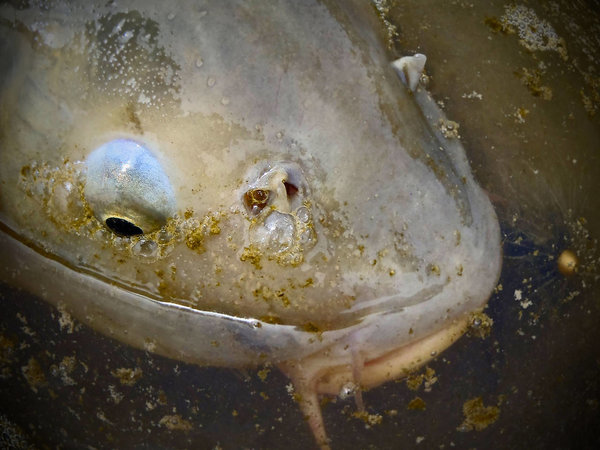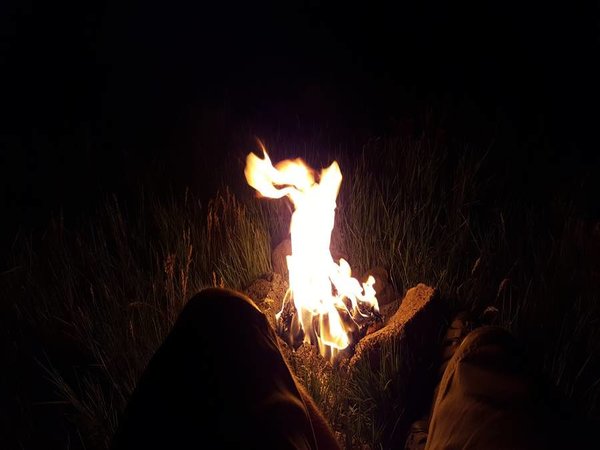I rested my river-chilled feet on the warm rocks of the small campfire, an iced gin-and-tonic spritzer in hand, helping me push the season as quickly as I could. The desert, lush and alive this time of year, cascaded my little camp with a chorus of wild tunes ranging from the shrill aria of the mud swallows to the cacophony of hoots, grunts and whistles from the waterfowl padding through the shallow waters just a few dozen feet away.
A solitary coyote yipped in the distance, and another, likely miles away, answered the call, sending the song running over the water beneath a night sky adorned by a million pinpricks of light. The dogs, resting in the tall grass on the edge of the firelight, lifted their heads at the call of the wild, but quickly dropped their muzzles and closed their eyes again, as if knowing that hearing the wild and being the wild are entirely different propositions.
And in the skinny, marshy, spring-fed bay of the Snake River, just off in the night, giant fish breached from the water, creating a splashy, water-park symphony of chaos. Here, miles from the nearest sewage pond, urban canal or city park pond, giant, river-dwelling carp prepared to spawn.
And I was the only guy around the campfire. Drinking alone. Fly fishing for carp in the wilderness. Two things frowned upon by many.
But, it is spritzer season. That spritzers and carp frolicking on the flats happen to coincide in desert rivers and the shallows of far-flung western reservoirs is just … a happy accident.
When I first moved to Idaho nearly two decades ago, I held carp in typical disdain. They swam in tainted waters, dined indiscriminately—vegetable, mineral or otherwise—and sported a face even a mother would abandon. They were (and still are) hell on rivers and lakes, displacing native species, stirring up sediment and generally making a mess of everything.
But a spring day spent on the Snake about 15 years ago converted me into a carp addict—the ultimate fly fishing dirtbag. I went to the river to chase smallmouth bass. I left the river in awe of these exotic creatures that flooded the flats to spawn and eat, yet proved so challenging to pursue. And I go back every spring, hoping to convince just one of these massive invaders to suck in a fly and take me into my backing. Because, when you’re lucky enough to hook one, they do. Every. Damn. Time.

Here in the West, just about the time the lilacs come into bloom (I knew I had a problem when I started calling these beautiful purple blossoms “carp flowers”), it’s a good bet that carp are moving around in high-desert reservoirs and slow-moving bottomland rivers. They’re spring spawners (of the broadcast, piscene orgy variety), and the warmer waters of the more static shallows appeal to the big females preparing to spill eggs. The males, of course, follow the females to the flats and shallows, bumping them and nudging them hoping the girls will eventually “get in the mood” and drop their eggs. When the females do, the males quickly and ably fertilize them. There’s no pairing up. No hollowing out a redd. No babysitting the eggs. It’s a messy, yet terribly effective and indiscriminate process that has contributed greatly to one of the nation’s most troubling invasive species challenges that can only be truly understood after you’ve had to scrape gelatinous, fertilized carp eggs off your shins with a stick without losing your lunch in the process.
But, damn, they’re fun on a fly rod. Despite a fairly mature conservation ethic, I must respect a fish that pulls so hard, fights with such gusto and has the ability to live damn near anywhere. Yes, those urban ponds and canals have earned their due as honest-to-God carp fisheries, but catching them in the wild is a different experience, and in big water, where they grow to match their environment, they might be the ultimate freshwater fly fishing target.
And across the West, they live in big water. From the desert impoundments of southeast Wyoming, to the bays and bluffs of Montana’s Yellowtail Reservoir, carp are now sought-after fly fishing targets. On Utah’s Flaming Gorge and Idaho’s American Falls reservoirs, they’re becoming staples for anglers looking for something big and nasty that’ll stretch an 8-weight to its limits. And in the rivers above and below these lakes, Cyprinus Carpio are dominant in terms of biomass and in their position atop the food chain.
And that means, of course, that they’ll eat damn near anything. In urban environs, where park trails wander along ponds and canals teeming with carp that have become conditioned to being given the unwanted remnants of a turkey sandwich, the fishing can be surprisingly easy. It’s one thing to tempt a city-park carp to the surface with a foam fly that looks suspiciously like a crust of bread or a Dorito. It’s quite another to bring in a 30-pound beast from a wild western river that you coaxed to hand thanks to carefully cast size 12 damselfly pattern along line of cattails in a foot of murky water.
Wilderness carp. It sounds like an oxymoron, but, just like the guys who chase these massive fish along the rocky flats of remote Beaver Island in Lake Michigan, it’s becoming more common for anglers to pursue these Asian invaders in traditionally wild American waters that course through wild American places. And under unsettled spring skies, when high-country trout streams are blown out with runoff or, better yet, still locked up in winter’s grip, carp offer a shoulder-season opportunity for which die-hard fly fishers are becoming very appreciative. If I had to pick which of the two I’d prefer to chase—trout or carp—I’d be hard-pressed to make the politically correct decision. Carp are, simply put, a more complete fly fishing target. Throw in the wild country element, and it becomes easier to listen to the cyprinid devil on my left shoulder and ignore the salmonid angel on my right.

I tossed another dried disc of cow dung on the little campfire, and took another sip of my cocktail, savoring the sounds of the desert. The coyotes kept up their songs well into the night, and the splashing and frolliking of the wild fish, born and reared in this backcountry desert river, echoed through the darkness.
I drink alone. I fly fish for carp in the wild.
I am a carp bum.
Chris Hunt.










